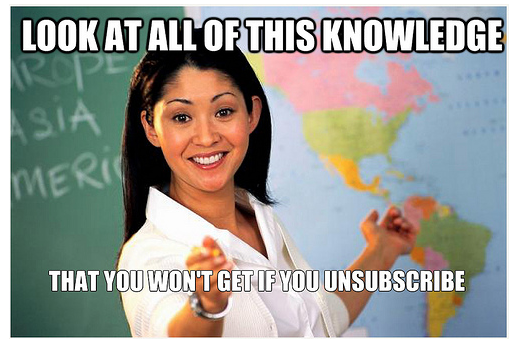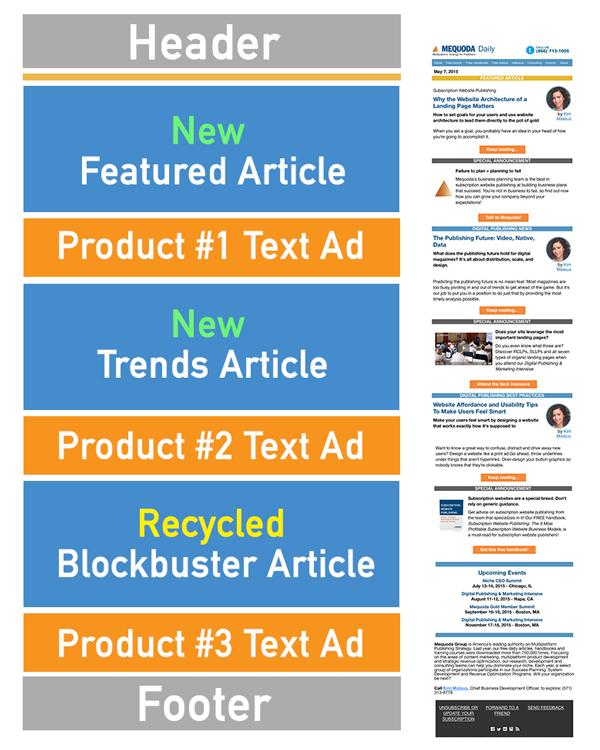
The best email marketing practices encourage responsive design, endless testing, and customer retention strategies
If you didn’t already know, the Mequoda Method is a compilation of best practices derived from publishers who are making money online. They tell us what’s working for them, and when we see a trend that’s working for other publishers, it becomes a best practice. This set of best practices is always evolving, growing and being updated to change with what’s working right now, not 12 months ago, and we don’t pretend to know what will happen 12 months from now, only what has been proven so far, and how it might apply to the future.
We also have the luxury of working with niche publishers day in and day out, who tell us their successes and failures, so we can leverage the collective wisdom of this forward-thinking group and develop new best practices.
Over the past few decades, we’ve listened to publishers’ stories of them weathering thunderstorm after thunderstorm, metaphorically speaking. And when you get a bunch of Master-level professionals together, you’ll also get a lot of humility, as we acknowledge we don’t know everything.
Based on their own experience, they have theories on what to do, why to do it, the order of importance, and what can and can’t happen if you follow best practices. When we find that other publishers share the same stories and we can measure what works and doesn’t, it becomes a best practice in the Mequoda Method.
We’ve found that best practices for the best email marketing advice is always changing. Five years ago, using full-length blog posts was the best way to convert readers into buyers through built-in calls to action. But now we find that getting readers out of email and onto the website, by using short snippets of content with links to the full-length articles is a best practice.
I can’t stress enough the importance of paying attention to what others are doing. It’s what the Mequoda Method was built on, and it’s always evolving based on true stories of what publishers are succeeding with and failing with. You should always learn by doing because until you hear the crack of thunder over head, you probably don’t really know if you know what to do.
The Best Email Marketing Techniques (as of today, and possibly tomorrow)
Test email subject lines
One of the most popular articles on our blog is our Best Email Subject Lines article which we’ve been recycling since 2009. And while we’ve seen other marketers try to copy it (lookin’ at you Hubspot with your list of 18), this list was crafted together with a team of award-winning copywriters who have used these formulas for decades, and have won awards for dramatic results with A/B email subject line tests.
While we find that every email subject line is a variation of one of these formulas, it’s how you use them that counts. Roll through them and test, test, test. Why get a 20% open rate when you can get 35%, or 45%, or more?
Be quick but don’t pull tricks
Short, mysterious subject lines are great for open rates but result in dismal click rates when they’re written as click-bait. Mystery is a good thing, just don’t cross the line of “tricking” your readers into opening an email that has content not in line with what you’re promising them. The email subject line is not creative if it prompts the recipient to open your email message, but subsequently disappoints, confuses, or worse, alienates the recipient.
Touch on people’s core emotions
In Axel Andersson and Bob Hacker’s book, The Secrets of Emotional, HOT-Button Copywriting, they define the “seven key copy drivers” as Fear, Greed, Guilt, Anger, Exclusivity, Salvation and Flattery. If you can provoke these emotions, you can provoke a response, whether it’s a portal comment or a sale.
Spruce up welcome emails
Write these as if they were handwritten letters. Thank them for subscribing, tell them what you usually write about, let them know how many times a week they’ll hear from you. If your list is segmented, point them in the direction of articles that you know will be of interest. Use this email to make a really great first impression.
Test “from” lines
You might be surprised that your “from” line is considered copy, but testing this line, perhaps changing it to the name of your editor, can have surprising test results, especially in B2C marketing. Internet copywriter Ivan Levison suggests testing the word “team” in your from line. “It makes it sound as if there’s a group of bright, energetic, enthusiastic people standing behind the product,” says Levison. At Mequoda, we’ve tested sending sales letter promotions from Don, with the from line of Don Nicholas. We get huge increases on opens with these efforts, but are careful not to overuse it.
Optimize unsubscribe links
Don’t hide your unsubscribe links or make them obscure. Keep people on your list by making them obvious, even funny. Here’s the unsubscribe button of one online marketer I subscribe to. The photo and joke changes every week. Additionally, keep people on your list by convincing them to stay with a carefully-crafted message on your unsubscribe page. Let them easily opt-out of daily emails and into weekly emails. And ask them to follow you on social media, such as Facebook, too so that you don’t lose them completely!

Win-back programs
Email relationships fade over time. Combat this by creating a new segmented list and offering creative incentives to those who have stopped opening and clicking.
Use the “tremendous whack” theory
Winston Churchill said, “If you have an important point to make, don’t try to be subtle or clever. Use a pile driver. Hit the point once. Then come back and hit it again. Then hit it a third time – a tremendous whack.”
Design responsively
Every inbox is different, and we’re already using simplistic HTML and inline CSS to conform for cross-compatibility. Responsive newsletter design isn’t much different. While the iPhone is known for rendering emails pretty seamlessly, Android devices can vary from their built-in email clients to their Gmail clients. And when you put the whole list together, you get a lot of different combinations, from the Kindle Fire to any different type of Android, and now to the iPhone 14 Pro.
In generalities, Email on Acid has identified these widths as ideal break points in your mobile email template. At Mequoda we have been successfully following these guidelines:
- A width less than 480px for the iPhone and smaller smart phones
- A width between 481px and 640px for medium sized Android devices
- A default dimension of 580px for tablets, web, and desktop email clients
Read more about how to upgrade your newsletter to be responsive.
Try an email stack
When we design mobile-first email newsletters, we focus on simplicity and thin width so that the content resizes easily on any size device. Below you can see what our new best-practice email template looks like in its most simple form.
We have three editorial snippets for the three articles we published that day. A featured post, a news post, and then a blockbuster post, which is recycled. Next to the template, you can see how Mequoda follows this method exactly. Every client who has converted to the three stack has seen an increase in traffic.

Create a sense of continuity
When writing a series of emails, you’ll increase click and open rates by telling readers that the email is part of a larger structure. To say “in the email we sent on Monday, we talked about XXXXX… now I want to talk about how XXXXX works with XXXXX”.
Don’t write off “free” completely
Using words like “free” are discouraged by some, but when they do get through spam filters, they perform at astonishing rates. Just don’t mix them with other spam trigger words like “trial,” “quote,” “sample,” “access” etc. which can put your spam score through the roof.
Look at your price and determine a length
The best email marketing advice we can offer when it comes to email promotions is the more money something costs, the more copy you have to write. You can get someone to sign up for a free webinar with 200 words, but a $1500 seminar could take 1500 words—or more! They might skim a longer email, but that’s OK as long as they can find the answer to every question they want to ask in order to make that buying decision.
What best email marketing practices would you add to this list? Which have you tried? Leave a comment and let us know.
About Mequoda Publishing Network: Mequoda provides actionable ideas, inspiration, and advice for gardeners, cooks, and crafting enthusiasts—with the goal of improving their lives and increasing personal enrichment and enjoyment. We operate five multiplatform consumer brands, including six magazines, 28 email newsletters, and more than 100 digital books. We partner with dozens of sponsors to help them market their products to our audiences.
For nearly two decades, Mequoda has explored and expanded the evolving art and science of multiplatform publishing and marketing. With in-depth research, aggressive testing, and cutting-edge strategy, Mequoda has developed a reputation as an industry leader for building and operating multiplatform communities that serve, engage and delight consumers, sponsors, and affiliates.
Contact: To learn more about our Email Marketing and Broadcasting Services, Exchange Program, or to become a marketing partner with any of our publications, please contact Christy Page at Christy@Mequoda.com or 781-556-1006.



Interesting tips! I’ll try them with my next campaign on GetResponse. Thanks for posting.
Interesting tips! I’ll try them with my next campaign on GetResponse. Thanks for posting.